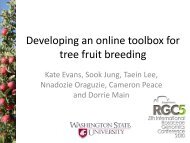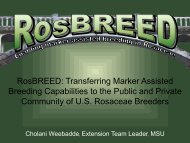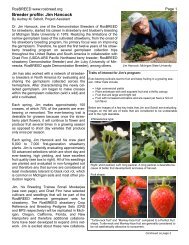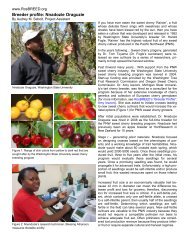Fragaria - RosBREED
Fragaria - RosBREED
Fragaria - RosBREED
Create successful ePaper yourself
Turn your PDF publications into a flip-book with our unique Google optimized e-Paper software.
<strong>RosBREED</strong> Strawberry<br />
Phenotyping Protocol<br />
Recording Sites:<br />
USDA-ARS/Oregon State University<br />
Michigan State University<br />
Driscoll’s Strawberry Associates California<br />
University of New Hampshire<br />
University of Florida<br />
<strong>RosBREED</strong>
Data Recording<br />
• Phenotype data should be entered in Excel in<br />
the format presented.<br />
-This will help us<br />
remain organized<br />
and keep consistency<br />
throughout our<br />
locations!
Data Sheet<br />
Orange = Fruit Traits<br />
Green = Plant/Leaf Traits<br />
Blue = Lab Procedures<br />
(not meant to be read)
Fruit Traits<br />
• Fruit weight (g)<br />
• Cap size<br />
• Soluble solids (°Brix)<br />
• Acidity (titration)<br />
• pH<br />
• % drip loss (after freezing and thawing)<br />
http://photojunction.blogspot.com/2008_<br />
0_01_archive.html<br />
• Appearance (rating; 1= very malformed; 9= symmetrical and<br />
attractive)<br />
• Fruit firmness (rating; 1= mush; 9= hard)<br />
• Skin Toughness (rating; 1=soft; 9=tough)<br />
• % of filled achenes<br />
• Monkey face (yes/no)
Fruit Traits Continued<br />
• External color ( rating; 1= white; 9= Deep red "black”)<br />
• Gloss (rating; 1=dull; 9=shiny)<br />
• Internal Color (rating; 1= white; 9= Deep red "black”)<br />
• Depth of internal color (%)<br />
• Ease of capping ( rating; 1= does not remove; 9= very easily<br />
removed)<br />
• Flavor (rating; 1= poor flavor; 9= excellent intense flavor)<br />
• Achene position (sunken/even/protruding)<br />
• Achene color (white, intermediate, red)<br />
• Crop estimate (rating 1=no fruit; 9=over-cropped)<br />
• Cyanidin content (Only NH)<br />
• Cyanidin/pelargonidin ratio (Only NH)<br />
• Anthocyanins total spectrophotometrically
Fruit Maturity and Harvest<br />
• Fruit should be harvested when fruit color<br />
(red, yellow, white) is fully developed (50% of<br />
fruit on plant is ripe) allowing evaluation of 10<br />
primary fruit<br />
• Record harvest date on<br />
data sheet<br />
• Fruit should be harvested<br />
as uniform as possible<br />
(same time each day).
Fruit weight (g, mean of 1 harvests)<br />
• 5 fruit from each genotype should be weighed<br />
and their mean recorded on the data sheet<br />
• Fruit can be weighed back in lab to speed<br />
harvest
Fruit Shape<br />
• Rate fruit 1-9 accordingly,<br />
• round conic to round<br />
9 7 5 3 1
Neck Line<br />
• Rating of 1-5 (1 sunken to 5 raised, ratings of 2<br />
and 4 for fruit that is in between)<br />
1 sunken neck 3 Flat neck 5 raised neck<br />
Note: Pictures are more drastic<br />
than would normally be observed
Fruit Measurement (cap size)<br />
Cap < width of fruit<br />
Cap ~ = width of fruit<br />
Cap > width of fruit
Appearance<br />
(rating; 1= very malformed;<br />
9= symmetrical and attractive)<br />
8<br />
General across bulk sample<br />
8-9
Percentage of filled achenes<br />
• Average rating of 5 fruit<br />
• Record percentage of achenes that filled<br />
• Example below is a “monkey face” distortion with 10-<br />
15% achenes unfilled. Please denote on data sheet<br />
“yes” if fruit distortion is monkey face.<br />
• Fruit with perfect shape but only a<br />
few achenes should be recorded as<br />
the % of their achenes and checked<br />
“no” for not “monkey face”<br />
http://www.omafra.gov.on.ca/IPM/english/strawbrries/insect<br />
s/tarnished-plant-bug.html
Fruit Firmness<br />
• Fruit firmness (rating; 1= mush; 9= hard)<br />
– measured by pressing on<br />
fruit. Test 1-2 fruit.<br />
• To keep data uniform this should be<br />
performed by ideally the same person (at each<br />
site) weekly
Toughness of Skin<br />
• Skin toughness is tested by rubbing skin of<br />
fruit with thumb. (rating; 1=soft; 9=tough).<br />
Test 1-2 fruit<br />
• To keep data uniform this should be<br />
performed by ideally the same person (at each<br />
site) weekly
1<br />
External Fruit Color<br />
• External color<br />
( rating; 1= white; 9= Deep red "black”)<br />
8 7 6<br />
8-9 8 7<br />
9
Gloss<br />
• Gloss (rating; 1=dull; 9=shiny)
Internal Fruit Color<br />
• Internal color ( rating; 1= white; 9= Deep red<br />
"black”) Would do fresh, unfortunately my<br />
only pics are after frozen and thawed.<br />
Basically a 1 on the left and a 7-8 on the right.
Depth of Internal Color<br />
• Depth of internal color (% of red at intervals of<br />
10) of 2 fruit, if both of these<br />
fruit appear to be different cut a<br />
third and so-on.<br />
• 0% red to 100% red
Flavor<br />
• If enough fruit are available.<br />
• rating; 1= poor flavor; 9= excellent<br />
intense flavor
Ease of Capping<br />
• rating; 1= does not remove; 9= very easily<br />
removed
Achene Position<br />
• Select from drop down list:<br />
• sunken/even/protruding<br />
Achene Color<br />
• Rate achene color on a 1-9 scale from<br />
Dark(brown-red) to Yellow
Crop estimate<br />
• (rating 1=no fruit; 9=overcropped)
% drip loss (after freezing)<br />
1.) Weigh 5-10 fruit from each genotype. Record<br />
the weight to the nearest 0.01g. AVOID LONG<br />
EXPOSURE TO THE AIR BEFORE WEIGHING (to<br />
minimize condensation).<br />
High drip loss<br />
2.) Record room temp. Transfer samples to a<br />
stainless steel mesh above a plate/bowl to<br />
catch liquid. Allow samples to sit for 3 hrs. or<br />
until they reach room temp.<br />
3.) After thawing transfer<br />
berries back to a tarred<br />
beaker and weigh,<br />
AVOID squeezing to<br />
release more juice.<br />
Low drip loss<br />
http://blog.calgarypubliclibrary.com/blogs/food/archive/2009/04.aspx
Grinding Samples<br />
After drip loss is measured, juice should be<br />
placed back with the sample and blended.<br />
An Osterizer blender can be used to do this<br />
or samples can be crushed in Ziploc bag<br />
pH, Titratable Acidity and<br />
Soluble Solids can be<br />
measured from this puree
pH<br />
• pH is then measured from the blended<br />
fruit/juice with a pH meter.
Soluble solids (°Brix)<br />
SS are measured by placing<br />
approximately 10g of puree onto the<br />
refractometer.
Acidity (titration)<br />
• 5 grams of puree is mixed with 45 ml of CO 2<br />
free water<br />
• CO 2 free water is made by starting with DI<br />
water then boiled and allowed to cool or the<br />
DI can be sonicated<br />
• Titrate with 0.1 normal NaOH
Total Anthocyanins<br />
• Determined by measuring the change in<br />
absorbance at 2 different pH values of 1.0 and<br />
4.5<br />
http://www.scielo.br/scielo.php?pid=S0103-<br />
90162010000100006&script=sci_arttext
Cyanidin/Pelargonidin<br />
• Cyanidin content<br />
• Cyanidin/pelargonidin ratio<br />
• Will be done by NH
Plant Traits<br />
• Period of flowering (evaluated weekly)<br />
• Peduncle Length<br />
• Genotype Sex<br />
• Vigor (rating; 1=dead; 9= extremely vigorous)<br />
• Number of runners<br />
• Leaf diseases<br />
– Powdery mildew Podosphaera aphanis (formerly Sphaerotheca macularis f. sp. fragariae)<br />
(rating 1=severe, 9=no symptoms)<br />
– Leaf spot Mycosphaerella fragariae (Tul.) Lindau (rating 1=severe, 9=no symptoms)<br />
– Leaf scorch Diplocarpon earlianum (rating 1=severe, 9=no symptoms)<br />
– Leaf blight Phomopsis obscurans (rating 1=severe, 9=no symptoms)<br />
– Powdery mildew on fruit (yes/no) Can consider rating severity if occurs.<br />
– Verticillium wilt Verticillium dahliae and V. albo-atrum if occurs (rating 1=severe, 9=no<br />
symptoms)<br />
– While a fruit trait and I doubt we will see differences unless really good year for it… we should<br />
probably consider scoring grey mold/botrytis<br />
– Need to consult with Vance and Phil. I am guessing they will also want Colletotrichum<br />
(Colletotrichum acutatum; C. gloeosporioides)and Midwest or east might want Bacterial<br />
Angular Leaf Spot Xanthomonas fragariae
Period of flowering (evaluated weekly)<br />
• Record blooming for each genotype weekly<br />
• Record if flowering is Above canopy, below<br />
canopy or is buried (at 50% bloom)<br />
• Record truss size (usually one of 3,5,7,9,11)<br />
• Record fruit set<br />
• Record peduncle length<br />
http://www.sierrapotomac.org/W_Needham/Strawberry_050710.htm
Peduncle Length<br />
Rate peduncle by above example of 5, 3 and 1<br />
(allowing for the lengths in-between)<br />
Ratings will be given by where the break is. A<br />
rating of 1 would be 90% after break, score of 3<br />
would be 50% of and score of 5 would be 20%<br />
Percent in 10% increments.<br />
.
Sex, Presence of Anthers<br />
• Record for each genotype if anthers are<br />
present or not.<br />
• Plants will be female if they have no anthers<br />
and bear fruit<br />
• Male, if plant has anthers and no fruit<br />
• Hermaphroditic, if plant has anthers and fruit
Vigor<br />
(Record twice)<br />
• (rating; 1=dead; 9= extremely vigorous)<br />
• Record at bloom and in late summer/fall (during<br />
runner count)<br />
• Spring vigor will determine winter hardiness<br />
• Fall vigor will help determine virus/disease
Number of runners<br />
• Record once in fall<br />
• rating; 1= 0 runners; 9= hundreds of runners.<br />
(Ideal rating 4-5, consisting of 5-6 runners)
Leaf diseases<br />
– Powdery mildew Podosphaera aphanis (formerly Sphaerotheca macularis f. sp.<br />
fragariae) (rating 1=severe, 9=no symptoms)<br />
– Leaf spot Mycosphaerella fragariae (Tul.) Lindau (rating 1=severe, 9=no<br />
symptoms)<br />
– Leaf scorch Diplocarpon earlianum (rating 1=severe, 9=no symptoms)<br />
– Leaf blight Phomopsis obscurans (rating 1=severe, 9=no symptoms)<br />
– Powdery mildew on fruit (yes/no) Can consider rating severity if occurs.<br />
– Verticillium wilt Verticillium dahliae and V. albo-atrum if occurs (rating<br />
1=severe, 9=no symptoms)<br />
– While a fruit trait and I doubt we will see differences unless really good year<br />
for it… we should probably consider scoring grey mold/botrytis<br />
– Need to consult with Vance and Phil. I am guessing they will also want<br />
Colletotrichum (Colletotrichum acutatum; C. gloeosporioides)and Midwest or<br />
east might want Bacterial Angular Leaf Spot Xanthomonas fragariae
Powdery mildew Podosphaera aphanis<br />
Note the curled leaves and<br />
gray patches on underside of<br />
leaves. Also, powdery mildew<br />
may not show up white and<br />
the only symptom would be<br />
curdled leaves.<br />
Powdery mildew symptoms has a<br />
grayish-white appearance on<br />
underside of leaves.<br />
http://plant-disease.ippc.orst.edu/disease.cfm?RecordID=1049
Leaf spot Mycosphaerella<br />
fragariae (Tul.) Lindau<br />
http://www.forestryimages.org/browse/detail.cfm?imgnum=1436090<br />
http://www.nysaes.cornell.edu/pp/extension/tfabp/lspsmf.shtml
Leaf scorch Diplocarpon earlianum<br />
http://www.omafra.gov.on.ca/IPM/english/strawberries<br />
/diseases-and-disorders/leaf-scorch.html<br />
http://www.extension.umn.edu/GardenInfo/diagnostics/fruit<br />
/strawberry/leavesspots.html
Leaf blight Phomopsis obscurans<br />
http://strawberryplants.org/2010/05/strawberry-plant/<br />
http://www.weedimages.org/browse/detail.cfm?imgnum=5385825
Powdery mildew on fruit<br />
http://www.gov.mb.ca/agriculture/crops/fruit/blb01s08.html
Verticillium wilt Verticillium dahliae<br />
and V. albo-atrum<br />
http://strawberryplants.org/2010/05/strawberry-plant/
grey mold/botrytis<br />
http://www.inra.fr/hyp3/pathogene/6botci5.htm<br />
http://www.gov.mb.ca/agriculture/crops/fruit/blb01s08.html
Colletotrichum acutatum; C.<br />
gloeosporioides<br />
http://www.insectimages.org/browse/detail.cf<br />
m?imgnum=5407876<br />
http://strawberry.ifas.ufl.edu/plantpathfiles/colletotcrownr<br />
ot.htm
Bacterial Angular Leaf Spot<br />
Xanthomonas fragariae<br />
http://www.eppo.org/QUARANTINE/bacteria/Xanthomo<br />
nas_fragariae/XANTFR_images.htm<br />
http://strawberry.ifas.ufl.edu/plantpathfiles/diseasegallery6.htm
Ideal leaf size for a DNA extraction<br />
Examples of newly emerging still folded leaves








